Marketers have mastered the who — age, income, geography. But in 2026, winning brands are obsessed with the why. Why people buy, why they churn, why they stay loyal to one brand and ghost another overnight. That’s where psychographic segmentation steps in — the art and science of understanding your customer’s mindset, not just their metrics.
It’s no longer enough to know that a shopper bought sneakers last month. You need to know if they’re motivated by fitness goals, fashion trends, or environmental values. And with AI now decoding behavior in real time, psychographic segmentation isn’t just a research tool — it’s the engine driving hyper-personalized engagement, deeper loyalty, and lasting brand growth.
What is Psychographic Segmentation?
Psychographic segmentation helps you categorize customers based on their psychological and cognitive attributes. These include beliefs, attitudes, values, personality traits, interests, and social status.
These can uplift your marketing campaigns, as 95% of customers make purchasing decisions using their subconscious mind. By grouping customers along these traits, you can personalize campaigns.
A psychographic study also helps brands position their identity based on their core customer base. For example, motorcycle maker Harley-Davidson uses the tagline ‘Live Free, Ride Hard’ to appeal to its loyal clientele, which values freedom, adventure, and rebellion.

A Harley Davidson campaign highlighting the value of freedom
Customers need to believe you value their beliefs. Today, brands stand by causes such as environmental sustainability, women’s rights, and equal opportunities.
Psychographic Segmentation vs. Demographic Segmentation
Psychographic segmentation is different from other methods like demographic, geographic, behavioral, firmographic, RFM segmentation, needs-based, and benefit segmentation.
Here are the differences between psychographic and demographic segmentations:
| Features | Demographic segmentation | Psychographic segmentation |
| What is it based on? | Observable characteristics | Psychological and cognitive traits |
| Incorporated data | Age, gender, income, education level, or family size | Customer engagement platform, surveys, and purchase history |
| Segment examples | Millennials, urban dwellers, women | Tech-savvy, health-conscious, luxury-oriented |
| Data collection method | Customer engagement platform, surveys, purchase history | Customer engagement platform, surveys, focus groups, social media listening |
| Challenges | Ignores nuance and why customers buy | Difficult to quantify |
What are the Benefits of Psychographic Segmentation?
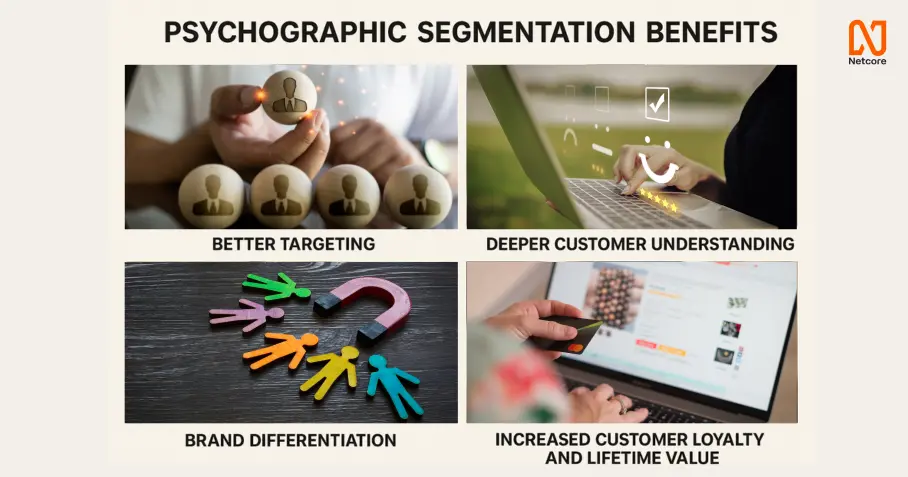
Understanding customer psychology can prove invaluable for marketers, as it lets them tap into the hidden desires and fears of customers. The benefits of psychographic segmentation are many:
1. Better Targeting
Psychographic segmentation lets you tailor marketing campaigns that target customers’ subconscious minds and evoke the desired emotional response from them. These messages are more likely to resonate, leading to better engagement and conversions.
For instance, Sterling achieved a 13.4% higher revenue by relying on Netcore’s AI-driven segmentation. By studying their customers’ behavior and psyche, they were able to create unique customer journeys for their campaigns by sending targeted messages across multiple communication channels.
By sending the right message to the right audience at the right time, Sterling Holidays reduced customer churn and improved conversion rates for its holiday packages.
2. Deeper Customer Understanding
Psychographic segmentation gives you a deeper layer of a customer’s persona by identifying motivating factors that trigger them to take action.
With this deeper understanding, you can design campaigns that resonate deeply with your customer’s values and emotions. For example, if you have identified a segment of the audience that are environmentally conscious, you can create marketing campaigns that are centered around such causes. This creates a positive brand image in the minds of customers, leading to better engagement, trust and meaningful relationships.
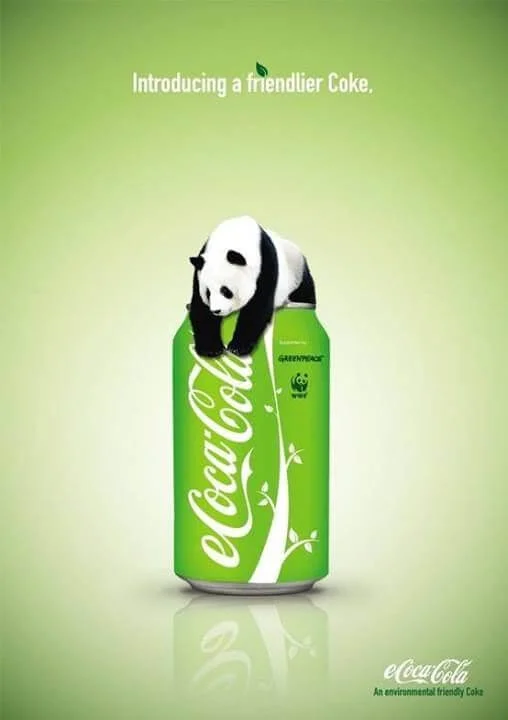
Coca-Cola’s green marketing targets environmentally-conscious customers
3. Brand Differentiation
According to an article in Harvard Business Review, psychographics has proved effective in brand reinforcement and positioning. Appealing to the emotional aspects of customers opens opportunities to conduct campaigns in niches that are uncommon and overlooked yet hold an important place in the hearts of customers. Crafting messages that appeal to these aspects get higher attention, have better appeal, and last longer in the minds of customers.
4. Increased Customer Loyalty and Lifetime Value
Psychographic segmentation helps connect your brand on a deeper level with customers, making them feel more understood and valued. This in-turn aids in recall and creates a positive brand image, making them return to make repeat purchases, improving customer lifetime value.
What Are the Different Types of Psychographic Segmentation?
Psychographic segmentation goes beyond demographics like age or income, it digs into why people buy. It helps you understand what motivates your customers, what they value, and how they see themselves. Let’s break down the four key types:
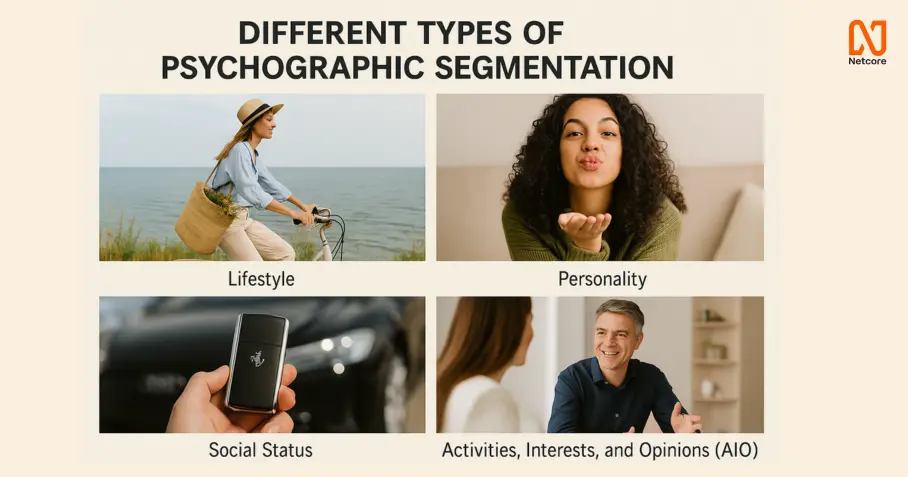
1. Lifestyle
Lifestyle segmentation groups customers based on how they live — their daily habits, spending choices, and priorities.
Example: An eco-conscious shopper who cycles to work and buys organic food is very different from a luxury traveler who values convenience and exclusivity.
Use Case:Brands like Nike and Lululemon thrive on lifestyle-based marketing, appealing to people who see fitness as an identity, not just a hobby.
2. Personality
This approach classifies customers by personality traits like introversion, openness, or ambition shaping how they respond to messages and products.
Example: A risk-taker may jump on a new fintech app early, while a cautious investor needs reassurance and testimonials.
Use Case: Apple designs its messaging for bold, innovative personalities who identify with creativity and independence.
3. Social Status
Social class and perceived status influence what people buy, and why.
Example: High-status consumers may lean toward premium or exclusive brands (think Rolex or Tesla), while value-driven shoppers may prefer functional and affordable options.
Use Case: Ecommerce brands often tailor campaigns by segment, luxury buyers get VIP previews, while value seekers receive bundle or loyalty offers.
4. Activities, Interests, and Opinions (AIO)
This classic psychographic model captures what people do, what they enjoy, and what they believe in offering a complete picture of their lifestyle mindset.
Example: A consumer who follows sustainability blogs, attends green events, and supports ethical brands signals strong environmental alignment.
Use Case: Platforms like Spotify and Pinterest use AIO data to personalize experiences recommending playlists or content based on hobbies and personal values.
Why It Matters
When you combine these four dimensions lifestyle, personality, social status, and AIO — you move from selling to customers to speaking like them.Psychographic segmentation is what transforms marketing from transactional to truly human.
How to Create Psychographic Segments?
In the book The Marketing Edge, the authors say that a segment specialist would enjoy the first-mover advantage until competitors start replicating their approach. This holds for psychographic segmentation too. Here are the steps to implement it:
Step 1: Define Goals
Lay out what you want to achieve with psychographic segmentations and how that fits your organizational goals. Consider these questions while defining your purpose:
- Are you planning to launch targeted marketing campaigns?
- Are you looking to identify new market segments for product expansion?
- Are you planning to improve your market share?
- Do you wish to build customer retention and loyalty?
- Do you aspire to brand differentiation?
Step 2: Conduct Research
Zero in on traits you plan to capture and standardize responses that would indicate them. There are various variables you can consider while capturing and segmenting psychographic data:
1. Interests: Includes areas customers most care about and spend their time pursuing.
Example: Particular kinds of sports or movie genres.
2. Attitudes: Customers acquire beliefs, values, and outlooks through their upbringings, communities, and experiences.
Example: Being environmentally conscious and cautious about your carbon footprint.
3. Social status: This is based on both the social and economic position of customers. In some societies, social markers of ethnicity and caste are still prominent, while in others, economic markers of class influence buying decisions. A combination of both can exist too.
Example: Owning a Mercedes-Benz car indicates a higher social status.
4. Lifestyle: Purchasing power of customers doesn’t always determine the way they live. Forces of globalization also influence lifestyles.
Example: Preferring a health-conscious diet.
5. Personality: Customers may be introverted/extroverted, creative, flexible, honest, humble, ambitious, or conscientious. These attributes might influence buying decisions.
Example: Ambitious customers may value goods and services that help them achieve a higher social or economic status, such as owing a Harley Davidson motorcycle.
Step 3: Analyze Findings
Use statistical techniques to identify patterns and correlations in data. Perform cluster analysis by grouping customers with similar psychographic traits.
For instance, a person interested in fashion could value sustainable clothing and animal rights.
Step 4: Create Personas, Integrate with Other Segmentations
Create personas based on psychographic segmentation. These should seem like real people with defining psychological and cognitive traits.
Example: Sarah values wellness and balance between work and life. She practices yoga regularly and likes to spend time with her family. Together, they travel every six months.
Next, correlate psychographic data with other segmentations based on demographics, behaviors, geography, and so on.
Step 5: Create targeted campaigns, inform product development
Tailor messages that resonate with each psychographic segment. Use an omnichannel strategy to engage customers across email, social media, and mobile phone messaging channels.
Align product and service offerings with each segment’s desires to maximize conversions. This opens up a window to partner with product and design teams.
For instance, Amazon launched the Amazon Saheli offering to promote women entrepreneurs in India. This aims at widening offerings on its platform and capturing the attention of customers who value women’s empowerment.

The Amazon Saheli program to empower women entrepreneurs
Step 6: Evaluate and Improve
Evaluate the performance of your marketing efforts against previous strategies and stated goals. Go over metrics like the cost of customer acquisition, most effective channels, retention rates, engagement rates, lifetime value, conversion rate, and time-to-conversion.
Examples of Psychographic Segmentation
Value & Attitude Segmentation
For example, an apparel brand identifies a significant chunk of its customers that is deeply concerned about environmental impact and are eco-conscious. So it launches a marketing campaign targeting them by showing how they have been associated with business practices that are eco-friendly and sustainable. The brand reiterates its use of organic material and fair labor practices.
Food Tech service
A food delivery app identifies a customer segment that shows aggressive buying around weekend European football league matches. The company offers special offers for these customers around the match hours. On the same basis, the app company can derive a similar behavior on other major events or days with long weekends and plan campaigns suited to that occasion.
Personality Trait Segmentation
This kind of segmentation identifies users basis their inherent characteristics such as extroversion, interoversion or conscientiousness. An example in this case would be a travel company targeting extroverts with exotic locations or experiences that are unique. Or an interior decorating brand can focus on consumers who prefer comfort by showcasing cozy rooms with great ambience and lighting.
Lifestyle Segmentation
Lifestyle segmentation focuses on the way customers live their lives, their daily activities and opinions. For example, there is a segment of audience focused on health and wellness activities like yoga, exercising and meditation. Understanding these aspects of customers, brands can tailor messages that focus on wellness and healthier ways of living to resonate with their customers.
Examples of Brands Using Psychographic Segmentation
1. Airbnb
Airbnb caters to travelers looking for authentic and unique experiences, offering a platform that showcases distinctive accommodations and local adventures. This approach attracts adventurous and open-minded individuals who crave more than just a place to stay.
The company understands its customers’ desire for personalized and memorable travel experiences, which enables it to effectively connect with a market segment passionate about exploration and cultural immersion. By focusing on these elements, Airbnb resonates deeply with those seeking to fully immerse themselves in new environments.
Through its strategy, Airbnb not only offers a service but also fosters a sense of community among its users. The platform’s emphasis on unique, local experiences encourages travelers to engage deeply with their destinations, enhancing their overall travel experience and satisfaction.
2. Old Spice “The Man You Could Smell Like” Campaign
Old Spice masterfully infused humor, confidence, and masculinity into their campaigns, targeting men who embrace self-assurance and adventure. This approach was designed to resonate deeply with a demographic known for valuing wit and a sense of daring.
In 2010, Old Spice embarked on a strategic mission to rejuvenate its brand image, aiming to attract a younger, more modern audience. This pivot introduced the iconic “The Man Your Man Could Smell Like” campaign, which broke conventional norms.

The campaign uniquely targeted female consumers, a shift from the traditional male-focused advertising in the toiletry sector. This innovative approach was a gamble that paid off handsomely, as it engaged an often-overlooked influencer in men’s product purchases—women.
This strategy led to an impressive 60% increase in sales shortly after the campaign’s launch, which had doubled by July 2010. Old Spice’s success story underscores the powerful impact of understanding and leveraging consumer psychographics in marketing.
3. Patagonia Eco-friendly Outdoor Gear
Patagonia caters to outdoor enthusiasts and environmentally conscious consumers, highlighting their dedication to environmental sustainability alongside their high-quality outdoor gear. Their marketing initiatives prominently showcase these eco-friendly practices, resonating deeply with those who prioritize nature and sustainable living.
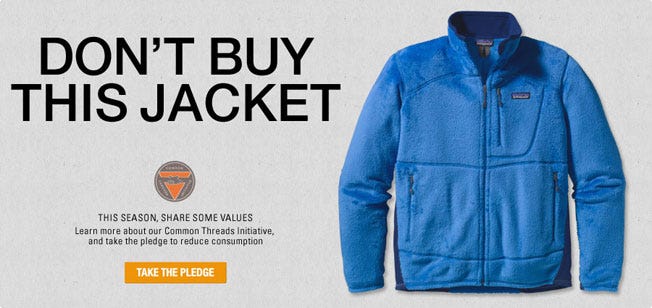
This strategic focus not only differentiates Patagonia in the marketplace but also strengthens its bond with a loyal customer base. By consistently emphasizing durability and responsible production, Patagonia appeals directly to individuals who value long-lasting products and ethical consumption.
Through this approach, Patagonia cultivates a sense of community and trust among its customers, reinforcing its brand as a leader in environmental advocacy within the apparel industry. This has proven effective in building lasting customer relationships based on shared values and commitment to the planet.
Best Practices for Psychographic Segmentation in Marketing
When you segment customers based on psychographic markers, it’s essential to follow certain practices for optimal results and derive a return on investment. Here are those practices:
1. Be transparent and value privacy: Inform your customers about how segmentation will help enhance their experience. Be clear about data collection and processing procedures.
2. Use technology: Use a unified software tool instead of relying on multiple disjointed tools to integrate and process data and launch targeted campaigns.
3. Refine segments: Create workflows to automate real-time updates of segments based on customer interactions. Review these updated segments to create related content pieces and launch marketing campaigns.
What Are Some of the Current and Future Trends in Psychographics?
Psychographics isn’t new — but how we use it has completely changed. What once required months of surveys and static audience personas can now happen in real time, powered by AI, behavioral data, and agentic marketing systems that continuously learn and adapt.
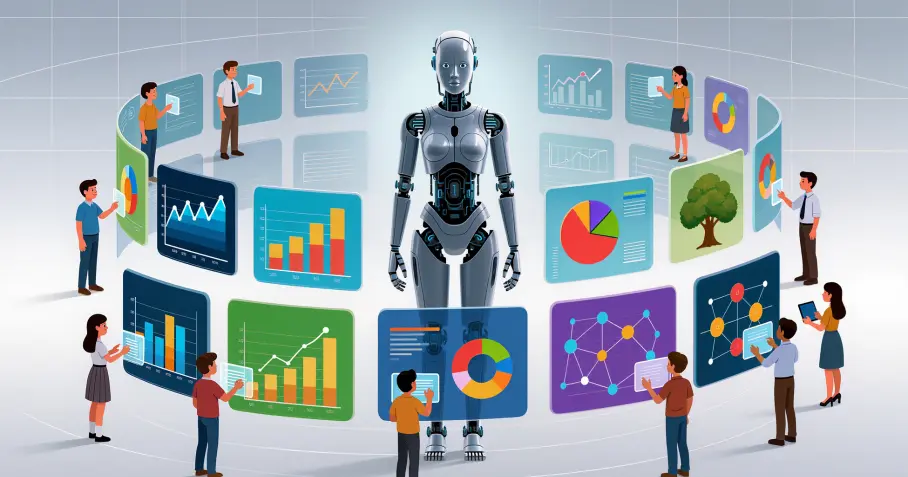
Let’s unpack what that evolution looks like.
1. Real-Time Psychographic Segmentation with AI
Traditionally, psychographic insights came from qualitative studies or panel research. Marketers grouped audiences based on fixed traits like lifestyle or attitudes.
Today, Agentic marketing platforms like Netcore can infer psychographics dynamically — by analyzing behavioral signals such as purchase intent, browsing depth, or engagement patterns.
Imagine identifying a “value-driven minimalist” not through a survey, but because the system detects they repeatedly filter for discounts yet avoid bundles or add-ons.
AI connects those micro-behaviors to underlying motivations, letting brands tailor experiences instantly.
2. The Rise of Agentic Marketing Systems
We’re entering the Agentic Marketing Era, where autonomous AI agents manage audience discovery, segmentation, and campaign execution without human micromanagement.
Instead of marketers setting static segments, these agents:
- Learn from behavioral and psychographic signals in real time
- Predict intent changes across customer journeys
- Adjust creative, channel, and timing autonomously
For example, an Agentic system could detect that a high-value “trend-seeker” customer is shifting toward “value-conscious” behavior during an off-season — and instantly pivot messaging to promote loyalty offers rather than premium drops.
That level of self-optimizing intelligence wasn’t possible before.
3. Psychographics Meets Behavioral and Contextual Data
Modern segmentation isn’t just who people are — it’s what they do and why they do it.
Future-forward brands combine psychographics (motivations, values) with behavioral data (clicks, opens, purchases) and contextual signals (time, channel, emotion) to create holistic profiles.
This blend allows for:
- Hyper-personalized storytelling — content that mirrors the customer’s mindset.
- Predictive engagement — messaging triggered before a need even surfaces.
- Adaptive customer journeys — experiences that evolve as psychographic patterns shift.
Agentic platforms make this continuous recalibration possible at scale.
4. Dynamic Personas: From Static to Self-Updating
The days of quarterly persona updates are over.
AI now keeps personas alive — continuously refreshing them based on evolving preferences and emotional cues.
If a customer who used to respond to aspirational luxury content starts engaging with sustainable or value-oriented campaigns, AI instantly reclassifies them and adapts recommendations.
In other words, personas evolve as people do.
5. Predictive Emotional Targeting
Next-gen psychographic models use emotion AI and sentiment analytics to understand why a user acts — not just what they do.
Agentic systems can detect emotional patterns in engagement (language, tone, pacing) and adjust outreach accordingly:
- Calm, empathetic tone for frustrated users.
- Upbeat, aspirational tone for achiever segments.
This shift makes marketing feel more human, not less.
6. Privacy-Conscious Personalization
The future of psychographic marketing isn’t about collecting more data — it’s about using data responsibly.
AI-driven segmentation now leverages anonymized intelligence, ensuring personalization without breaching privacy.
Platforms like Netcore are built on regional hosting, encryption, and compliance (GDPR, CCPA), ensuring that marketing evolution aligns with customer trust.
7. The Future: Agentic, Adaptive, Always-Learning
We’re heading toward an era where marketing systems think, decide, and act on psychographic cues autonomously.
As Agentic AI continues to mature, segmentation will become continuous — not campaign-based.
Marketers will move from building segments to training intelligent systems that detect, predict, and respond to human emotion and motivation in real time.
In short, psychographics is no longer a static framework — it’s a living, learning loop.
And platforms like Netcore are leading this shift, helping brands adapt to the evolutionary nature of today’s consumer: always changing, always connected, and always expecting relevance.
Final Take
Psychographic segmentation is no longer a “nice-to-have” — it’s the foundation of modern marketing. By understanding what truly drives your customers — their values, aspirations, and motivations — brands can move beyond surface-level demographics and start creating campaigns that feel deeply personal.
When done right, psychographics turns engagement into empathy. It allows you to speak your customers’ language, connect with their intent, and deliver experiences that inspire loyalty and long-term growth. And with the rise of AI and agentic marketing, this precision is now possible at scale.
That’s where Netcore stands out. As an AI-powered, agentic marketing platform, Netcore helps brands collect, interpret, and act on psychographic and behavioral insights in real time. You can:
- Build AI-led personalized journeys that evolve with customer behavior.
- Create dynamic product recommendations and tailor messaging by persona.
- Run A/B tests and predictive analytics to optimize every campaign before scaling.
- Gain a unified view of every customer for smarter, faster decisions.
In short, Netcore helps you transform insights into outcomes — turning every interaction into a moment of connection and every customer into a loyal advocate. Because the future of marketing isn’t just automated — it’s agentic, adaptive, and human at scale.
 2 YRS IN A ROW
2 YRS IN A ROW  Netcore Named a Leader in 2025 Gartner® Magic Quadrant™ for Search & Product Discovery
Netcore Named a Leader in 2025 Gartner® Magic Quadrant™ for Search & Product Discovery 







